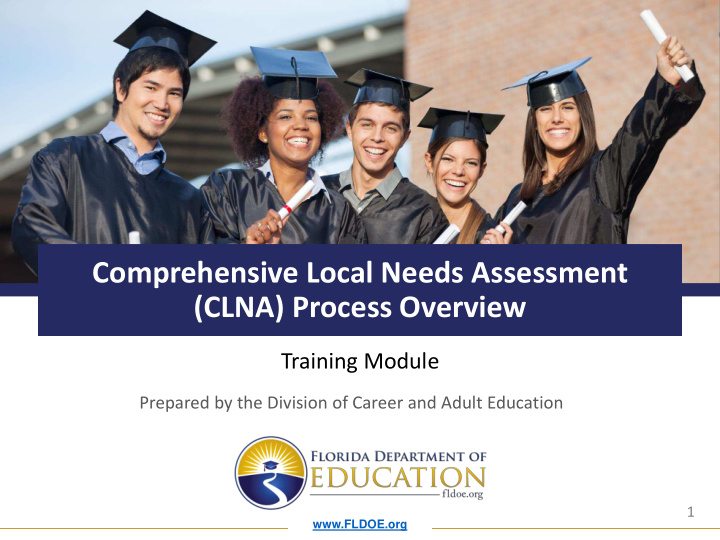



Comprehensive Local Needs Assessment (CLNA) Process Overview Training Module Prepared by the Division of Career and Adult Education 1 www.FLDOE.org
CLNA Presentation Overview This webinar will cover CLNA: • Process overview 2 www.FLDOE.org
CLNA Process Overview Pre-Plan • Determine tasks • Assign roles • Data Gather • Stakeholder input • Process, display, interpret, analyze, Analyze verify, and determine root causes Prioritize • Assess importance and achievability of needs • Yearly RFA Plan • 4-Year Plan • Budget 3 www.FLDOE.org
Pre-Planning As a Leadership Team • Create a CLNA leadership team and make assignments • Determine local, personalized priorities and purposes for the CLNA • Devise a timeline of major CLNA events • Identify data sources and analysis techniques • Determine strategies for stakeholder engagement and regional collaboration 4 www.FLDOE.org
Data Analysis Examples : • Student performance, equity, and access • Labor market information • Information on programs, and faculty and staff Look for: • Patterns • Trends • Gaps • Disparities Dig deeper by: • Corroborating results • Performing root cause analysis 5 www.FLDOE.org
Stakeholder Consultation Means: • Involve stakeholders as active co-creators of policies and programs. • Inquire for input on CTE weaknesses, strengths, opportunities, and barriers. • Inform stakeholders on a host of topics throughout the consultation process – the CLNA process, what CTE is, how they can get involved, etc. Reference: • Inspire stakeholders about the https://www2.ed.gov/about/inits/ed/implementation-support- unit/tech-assist/framework-communications-engagement.pdf importance of CTE as a critical means of shaping student’s career trajectories and the labor market. 6 www.FLDOE.org
Example Stakeholder Engagement Strategies and Opportunities • Input Through Existing Events - professional development, advisory meetings, CTE showcases, PTO meetings, CTSO events, etc. • Planned Discussions – regional summit, roundtable, focus group, work group, listening session, classroom discussions, etc. • Digital surveys – social media/blog, website, newsletter/listserv, e-blast, etc. • Webinars • Paper surveys - direct mail or in-class or in-meeting dissemination • Personalized emails • Phone conferences 7 www.FLDOE.org
Root Cause Analysis Investigate further to identify causes of the effects made known through data analysis and stakeholder engagement • Interview experts and stakeholders on causes • Corroborate results with additional data sources • Read evidence-based research • Brainstorm possible causes using: • The “Five Whys” technique • Fishbone diagraming 8 www.FLDOE.org
Prioritization of Results • You will not be able to address all identified needs • Strategize how you wish to accomplish high-priority and medium- priority needs in your short-term and long-term planning Low Achievability High Achievability Medium Priority High Priority High Importance Where possible, address Address in your short- in your long-term plans. term plans. Low Priority Medium Priority Low Importance Maintain a record of Where beneficial, address these. in your short-term plans. 9 www.FLDOE.org
The Start of Your RFA – Identifying Solutions to Your Needs Find Solutions Create Solutions • Read evidence-based • Analyze issues as a research to find leadership team to effective interventions come up with solutions • Ask similar agencies • Consult stakeholders on regarding what they viable options have tried, are trying, and what has been effective 10 www.FLDOE.org
For More Info: • Visit : http://www.fldoe.org/academics/career- adult-edu/Perkins/clna.stml • Email: Perkins@fldoe.org 11 www.FLDOE.org
www.FLDOE.org 12 www.FLDOE.org
Recommend
More recommend